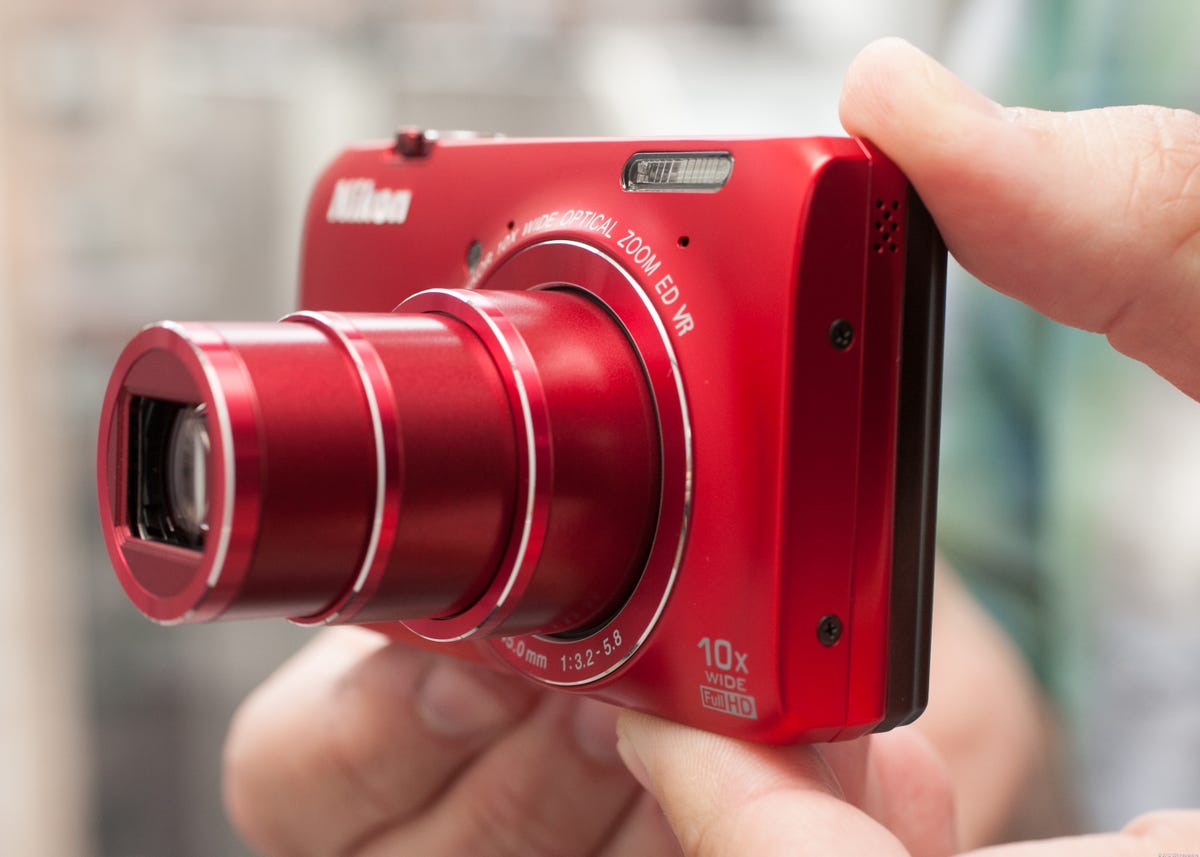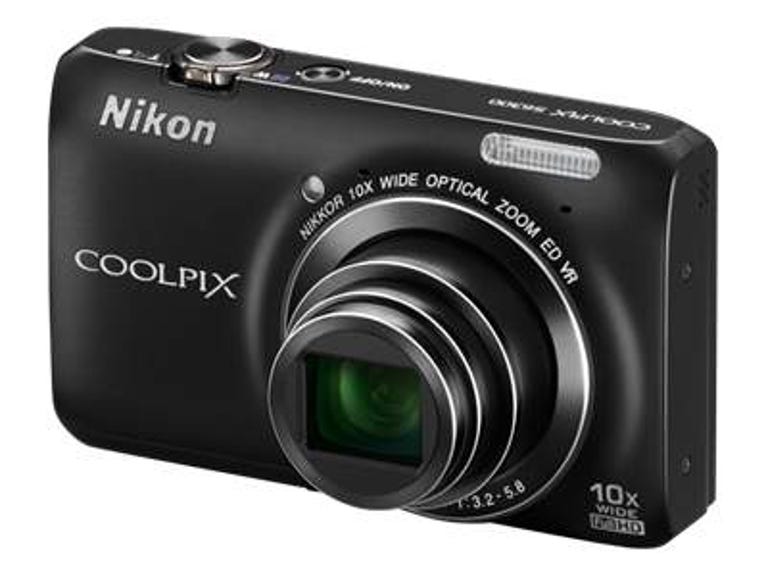 Why You Can Trust CNET
Why You Can Trust CNET Nikon Coolpix S6300 review: The S6300 isn't a bad way to get a 10x zoom lens in your pocket. However, its competition makes it a tougher sell.
The S6300 isn't a bad way to get a 10x zoom lens in your pocket. However, its competition makes it a tougher sell.
When the Nikon Coolpix S6300's predecessor, the S6200, came out, it was one of the smallest, least expensive 10x zoom cameras available. It was a good camera for what it was, but not exceptional.
The Good
The Bad
The Bottom Line
For the S6300, Nikon kept the body and lens of the S6200, but swapped out the CCD sensor for a backside-illuminated CMOS sensor. The change allowed Nikon to add some new shooting options including full HD and slow-motion movie capture and high-speed burst shooting -- up to 6 frames per second at full 16-megapixel resolution. It didn't do much to improve its low-light photo quality, though, which is disappointing.
And, unfortunately, every major manufacturer now has a similar camera in its lineup, so the S6300 has a lot of competition. The S6300 is definitely worth considering over similarly priced models with CCD sensors and it is still a small, lightweight way to put a 10x zoom in your pocket. But, Panasonic's SZ7 and Sony'x WX150 are better bets if you can afford them.
Picture quality
Overall photo quality from the S6300 is above average for this class of camera, suitable for prints up to 8x10 and Web use. At full size they don't look good, though, so its 16-megapixel resolution isn't a reason to buy. Though its sensitivity settings run from ISO 125 to ISO 3200, the S6300 is best used with plenty of light to keep sensitivity below ISO 400.
Regardless of sensitivity, photos appear somewhat soft and benefit from sharpening with photo-editing software. There's a Fixed Range Auto option that will limit you to ISO 125-400 or ISO 125-800; I recommend using the former outdoors and latter indoors when possible. The two highest ISOs -- 1600 and 3200 -- should only be used in emergencies, mainly because the colors get very washed out and the noise reduction makes subjects appear smeary, and actually, colors are so bad at ISO 3200 you probably shouldn't use it at all. (You can read more about the photo quality as well as view full-size samples in the slideshow above.)
Video quality is on par with a basic HD pocket video camera or smartphone; good enough for Web use and nondiscriminating TV viewing. The zoom lens does function while recording and while it moves fairly quietly, it shakes a bit as it extends and collapses. Also, it's not particularly quick to focus when zoomed in.

Shooting performance
Editors' note: We recently updated our testing methodology to gauge slightly more real-world performance, so the results aren't necessarily comparable with previous testing. Until we're finished refining our procedures, we will not be posting comparative performance charts.
The change from CCD to CMOS sensor has made a significant difference to this camera's performance. Again, this is essentially the same camera as the S6200, which was pokey at best. The S6300 doesn't start particularly fast, taking on average 2.9 seconds from off to first shot, the rest of its performance was respectable. Shutter lag -- from off to first shot without prefocusing -- in bright conditions was 0.3 second, but in more challenging light, that went up to 0.9 second. Shot-to-shot times averaged 1.5 seconds without flash and 2.3 seconds with.
Worth noting is that the camera's autofocus system is a bit temperamental and wouldn't always be in focus even when the camera said it was. This happened most frequently with the lens extended. It can mostly be avoided by prefocusing by half-pressing the shutter release, but if you're not the type to do that, you might want to cross this camera off your list.
The S6300 can shoot bursts at up to 6 frames per second for up to seven frames (though at its highest-quality setting, that dropped to 5.3fps). Once you release the shutter, though, you'll be waiting several seconds for the camera to process and store the photos before you can shoot again.
Design and features
While the S6300 looks chunkier than the Sony and Panasonic models mentioned earlier, it's still easy to pocket and very lightweight. Available in four colors, the metal body has a nice feel to it and is for the most part comfortable to use even at its small size.
The controls on back are small but nicely raised from the body, making them easy to press with some clicky feedback. There is a one-touch record button for movies, too, so you don't need to switch modes before you capture clips (however you'll have to wait a few seconds for it to start recording).
| Key specs | Nikon Coolpix S6300 |
|---|---|
| Price (MSRP) | $229.95 |
| Dimensions (WHD) | 3.7x2.3x1 inches |
| Weight (with battery and media) | 5.7 ounces |
| Megapixels, image sensor size, type | 16 megapixels, 1/2.3-inch BSI CMOS |
| LCD size, resolution/viewfinder | 2.7-inch LCD, 230K dots/None |
| Lens (zoom, aperture, focal length) | 10x, f3.2-5.8, 25-250mm (35mm equivalent) |
| File format (still/video) | JPEG/H.264 AAC (.MOV) |
| Highest resolution size (still/video) | 4,608x3,456 pixels/ 1,920x1,080 at 30fps |
| Image stabilization type | Optical and digital |
| Battery type, CIPA rated life | Lithium ion rechargeable, 230 shots |
| Battery charged in camera | Yes; wall adapter (included) or computer via USB |
| Storage media | SD/SDHC/SDXC |
| Bundled software | Software Suite for Coolpix (Windows/Mac) |
Like much of this camera, screen size, and resolution are OK for what you're paying, but nothing special. Despite the lower resolution, though, settings and menu text are sharp and easy to read. The camera, like most of Nikon's Coolpix models, is simple to operate. You'll still want to read the full manual (included as a PDF file on a CD), but straight from the box you'll be able to start shooting without much trouble.
Battery life is brief for the S6300. It's CIPA-rated for 230 shots, but I never got that far before it needed charging. That's mainly because doing anything other taking automatic shots drains the battery faster. The small pack charges via USB cable, too, so if you buy the S6300, expect a full charge to tie up your camera for about 3 hours. Also, the battery/SD card compartment door regularly opened accidentally while shooting and would frequently slide closed incorrectly.
| General shooting options | Nikon Coolpix S6300 |
|---|---|
| ISO sensitivity (full resolution) | Auto, 125, 200, 400, 800, 1600, 3200 |
| White balance | Auto, Custom, Daylight, Incandescent, Fluorescent, Cloudy, Flash |
| Recording modes | Auto, Scene auto selector, Scene, Special effects, Smart portrait, Subject tracking |
| Focus modes | Face priority, nine-area auto, manual with 99 focus areas, center, subject tracking |
| Macro | 4 inches (Wide) |
| Metering modes | Multipattern, Center-weighted (when using up to 2x digital zoom), Spot (digital zoom of 2x or more) |
| Color effects | Standard, Vivid, Sepia, Black & White, Cyanotype, Nostalgic sepia, High-contrast monochrome, High key, Low key, Selective color |
| Burst mode shot limit (full resolution) | Seven shots |
If you have no interest in controlling shutter speed and aperture, the S6300 is for you. There are two Auto modes on this camera. One is Nikon's Scene Auto Selector, located under the Scene modes. It adjusts settings appropriately based on six common scene types. If the scene doesn't match any of those, it defaults to a general-use Auto. Then there is a regular Auto mode, which is basically the Program mode you'd find on other cameras. It'll handle shutter speed and aperture settings, but you can also adjust things like ISO and white balance as well as film colors like Vivid, Sepia, and Cyanotype.
Aside from the Scene Auto Selector there are 19 other scene modes like Landscape and Portrait as well as modes for correcting backlit subjects, easy panorama photos (180 or 360 degrees), and handheld night shots. A separate Special Effects mode gives you some creative options like High-contrast Monochrome and Selective Color, which turns everything black-and-white except a color you specify. (The playback menu also has other effects filters you can apply after you shoot, like soft focus for a toy camera look and fish-eye.)
Conclusion: Recommended with reservations
The Nikon Coolpix S6300 is certainly an improvement over the model it replaces. Just the sensor change to BSI CMOS is enough to make it recommending over CCD-sensor-based competition. It's an easy-to-use camera, too, so if you're just looking for something inexpensive to toss in your bag that's better than your phone, it's a decent choice. However, both the similarly priced Panasonic Lumix SZ7 and slightly more expensive Sony Cyber-shot WX150 are better.


